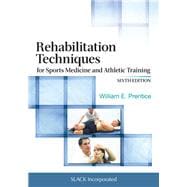Rehabilitation Techniques for Sports Medicine and Athletic Training, Sixth Edition is a comprehensive reference written for the athletic training student who is interested in gaining more in-depth exposure to the theory and practical application of rehabilitation techniques used in a sports medicine environment.
Dr. William Prentice and his contributors have collectively combined their expertise and knowledge to produce a single text that encompasses all aspects of sports medicine rehabilitation. This new Sixth Edition provides the athletic trainer with a complete guide to the design, implementation, and supervision of rehabilitation programs for sport-related injuries.
Rehabilitation Techniques for Sports Medicine and Athletic Training, Sixth Edition is intended for athletic trainers that deal with practical application of theory in a clinical setting. While a number of texts are available on the subject of rehabilitation of injury in various patient populations, Rehabilitation Techniques for Sports Medicine and Athletic Training, Sixth Edition concentrates exclusively on the application of rehabilitation techniques in a sport-related setting for a unique sports medicine emphasis.
New in the Sixth Edition:
• All new four color design
• More than 650 instructional high-resolution videos corresponding to a particular photograph
• Integrated laboratory manual
• More than 1,000 full-color images throughout
• New terminology to reflect the NATA Educational Competencies Fifth Edition
• Ancillary interactive website and instructor’s materials available
Instructors in educational settings can visit www.efacultylounge.com for additional materials to be used for teaching in the classroom.
Rehabilitation Techniques for Sports Medicine and Athletic Training, Sixth Edition is the perfect resource for athletic training students, faculty, and clinicians; physical therapists who manage rehabilitation programs for sports-related injuries; as well as for strength and conditioning coaches who supervise performance enhancement programs on return to play.
Dr. William Prentice and his contributors have collectively combined their expertise and knowledge to produce a single text that encompasses all aspects of sports medicine rehabilitation. This new Sixth Edition provides the athletic trainer with a complete guide to the design, implementation, and supervision of rehabilitation programs for sport-related injuries.
Rehabilitation Techniques for Sports Medicine and Athletic Training, Sixth Edition is intended for athletic trainers that deal with practical application of theory in a clinical setting. While a number of texts are available on the subject of rehabilitation of injury in various patient populations, Rehabilitation Techniques for Sports Medicine and Athletic Training, Sixth Edition concentrates exclusively on the application of rehabilitation techniques in a sport-related setting for a unique sports medicine emphasis.
New in the Sixth Edition:
• All new four color design
• More than 650 instructional high-resolution videos corresponding to a particular photograph
• Integrated laboratory manual
• More than 1,000 full-color images throughout
• New terminology to reflect the NATA Educational Competencies Fifth Edition
• Ancillary interactive website and instructor’s materials available
Instructors in educational settings can visit www.efacultylounge.com for additional materials to be used for teaching in the classroom.
Rehabilitation Techniques for Sports Medicine and Athletic Training, Sixth Edition is the perfect resource for athletic training students, faculty, and clinicians; physical therapists who manage rehabilitation programs for sports-related injuries; as well as for strength and conditioning coaches who supervise performance enhancement programs on return to play.








